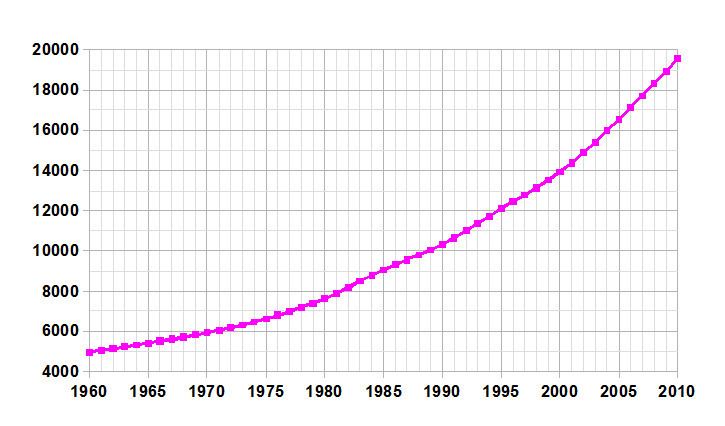 | ||
This article is about the demographic features of the population of Angola, including population density, ethnicity, education level, health of the populace, economic status, religious affiliations and other aspects of the population.
Contents
- Map of Angola
- Population
- Vital statistics
- Fertility and Births
- CIA World Factbook demographic statistics
- Population growth
- Sex ratio
- Health
- Ethnic groups
- Religions
- Education
- Languages
- References
Map of Angola
According to 2014 census data, Angola had a population of 24.3 million inhabitants in 2014. Ethnically, there are three main groups, each speaking a Bantu language: the Ovimbundu who represent 37% of the population, the (Ambundu) with 25%, and the Bakongo 13%. Other numerically important groups include the closely interrelated Chokwe and Lunda, the Ganguela and Nyaneka-Khumbi (in both cases classification terms that stand for a variety of small groups), the Ovambo, the Herero, the Xindonga and scattered residual groups of Khoisan. In addition, mixed race (European and African) people amount to about 2%, with a small (1%) population of whites, mainly ethnically Portuguese.
As a former overseas territory of Portugal until 1975, Angola possesses a Portuguese population of over 200,000, a number that has been growing from 2000 onwards, because of Angola's growing demand for qualified human resources. Besides the Portuguese, significant numbers of people from other European and from diverse Latin American countries (especially Brazil) can be found. From the 2000s, many Chinese have settled and started up small businesses, while at least as many have come as workers for large enterprises (construction or other). Observers claim that the Chinese community in Angola might include as many as 300,000 persons at the end of 2010, but reliable statistics are not at this stage available. In 1974/75, over 25,000 Cuban soldiers arrived in Angola to help the MPLA forces during the decolonization conflict. Once this was over, a massive development cooperation in the field of health and education brought in numerous civil personnel from Cuba. However, only a very small percentage of all these people has remained in Angola, either for personal reasons (intermarriage) or as professionals (e.g., medical doctors).
The largest religious denomination is Roman Catholicism, to which adheres about half the population. Roughly 26% are followers of traditional forms of Protestantism (Congregationals, Methodists, Baptista, Lutherans, Reformed), but over the last decades there has in addition been a growth of Pentecostal communities and African Initiated Churches. In 2006, one out of 221 people were Jehovah's Witnesses. Blacks from Mali, Nigeria and Senegal are mostly Sunnite Muslims, but do not make up more than 1 - 2% of the population. By now few Angolans retain African traditional religions following different ethnic faiths.
Population
According to the 2010 revision of the World Population Prospects the total population was 19 082 000 in 2010, compared to only 4 148 000 in 1950. The proportion of children below the age of 15 in 2010 was 46.6%, 50.9% was between 15 and 65 years of age, while 2.5% was 65 years or older .
Structure of the population (DHS 2011) (Males 19 707, Females 20 356 = 40 063) :
Vital statistics
Registration of vital events is in Angola not complete. The Population Department of the United Nations prepared the following estimates.
Fertility and Births
Total Fertility Rate (TFR) and Crude Birth Rate (CBR):
CIA World Factbook demographic statistics
The following demographic statistics are from the CIA World Factbook, unless otherwise indicated.
Population
Population growth
The population is growing by 2.184% annually. There are 44.51 births and 24.81 deaths per 1,000 citizens. The net migration rate is 2.14 migrants per 1,000 citizens. The fertility rate of Angola is 5.97 children born per woman as of 2011. The infant mortality rate is 184.44 deaths for every 1,000 live births with 196.55 deaths for males and 171.72 deaths for females for every 1,000 live births. Life expectancy at birth is 37.63 years; 36.73 years for males and 38.57 years for females.
Sex ratio
Health
According to the CIA World Factbook, 2% of adults (aged 15–49) are living with HIV/AIDS (as of 2009). The risk of contracting disease is very high. There are food and waterborne diseases, bacterial and protozoal diarrhea, hepatitis A, and typhoid fever; vectorborne diseases, malaria, African trypanosomiasis (sleeping sickness); respiratory disease: meningococcal meningitis, and schistosomiasis, a water contact disease, as of 2005.
Ethnic groups
Roughly 37% of Angolans are Ovimbundu, 25% are Ambundu, 13% are Bakongo, 2% are mestiço, 1-2% are white Africans, and people from other African ethnicities make up 22% of Angola's population.
Religions
Angola is a majority Christian country. Official statistics don't exist, but it is estimated that over 80% belong to a Christian church or community. More than half are Roman Catholic, the remaining ones comprising members of traditional Protestant churches as well as of Pentecostal communities. Only 1 - 2% are Muslims - generally immigrants from other African countries. Traditional indigenous religions are practized by a very small minority, generally in peripheral rural societies.
Education
Literacy is quite low, with 67.4% of the population over the age of 15 able to read and write in Portuguese. 82.9% of males and 54.2% of women are literate as of 2001.
Languages
Portuguese is the official language of Angola, but Bantu and other African languages are also widely spoken. In fact, Kikongo, Kimbundu, Umbundu, Tuchokwe, Nganguela, and Ukanyama have the official status of "national languages". The mastery of Portuguese is widespread; in the cities the overwhelming majority are either fluent in Portuguese or have at least a reasonable working knowledge of this language; an increasing minority are native Portuguese speakers and have a poor, if any, knowledge of an African language.
